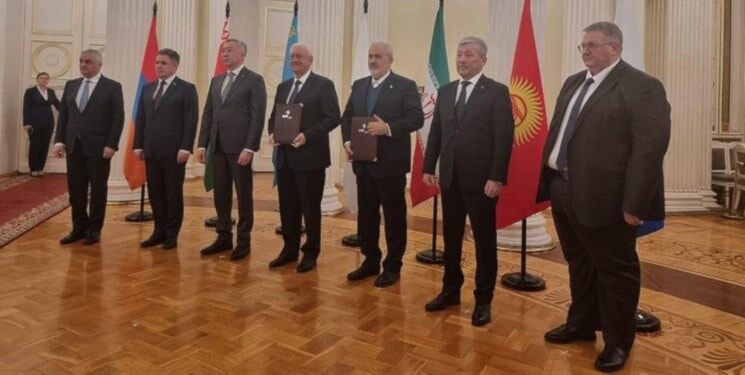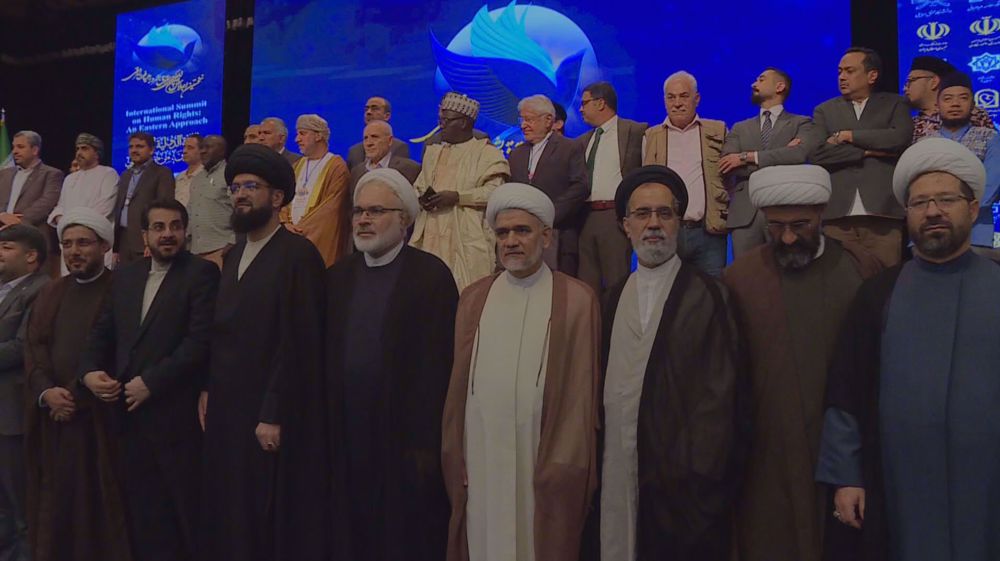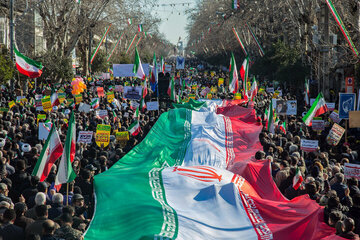Alwaght- Last week, Iran and the Eurasian Economic Union (EAEU) signed a long-waited free trade agreement. This agreement was one of the most highlighted events of the union’s meeting in St. Petersburg.
The first step for integrating Iran into the EAEU’s common market was taken on May 17, 2018, with the signing of a temporary agreement to establish a free trade zone between the two sides, which came into effect on October 27, 2019. During this period, the trade between Iran and the members of the economic union has seen growth every year, and according to Islamic Republic of Iran Customs Administrator, the trade volume between the new partners touched $4.2 billion record.
With finalization of the deal by parliaments of the member countries, bilateral trade and connection of Iran’s market to the members states will be accelerated, allowing a turnover of $18-20 billion in the next 5 years.
Non-ferrous metals, oil and gas products, wooden products and machinery, textile products and fruit and vegetables currently constitute the major share of the trade between the parties. Russian politicians say that this agreement is a logical move given the economic pressure caused by the unprecedented wave of sanctions imposed by the West against Moscow.
After agreement was signed, Prime Minister of the Russian Federation Alexey Overchuk said: “These are very good opportunities for the development and improvement of the economy of the five countries. We signed a free trade agreement that logically continues our great efforts in the past few years since the signing of the interim free trade agreement. During this period, trade between Eurasian countries and the Islamic Republic of Iran has tripled. We have reached a mutual understanding that we have reached a level that requires a full agreement to open the markets of the EAEU and the Islamic Republic of Iran. We did it today. The Islamic Republic of Iran can access the market of 190 million people, and the five member countries have gained the possibility of exporting goods to a market of about 86 to 87 million people.”
Maxim Chereshnev, a member of Russian General Business Council and the chairman of EAEU, said that the deal benefits Russia as the Russian goods on average account for nearly 70 percent of the EAEU trade with the third countries.
“Iran’s market is very big, and unlike other markets, companies from other foreign countries have a poor representation, and as a result, it reduces the level of competition Russian companies with others,” he said.
Also, Natalya Nikonorova, member of Federation Committee on Foreign Affairs in the Russian parliament believes that although Iran has been under sanctions for nearly 45 years, it has something to offer. Almost all economic sectors in this country are properly developed. Iran is one of the largest producers of gas globally and one of the leading producers of oil. Its heavy industry is very efficient. Motor vehicles made in Iran can also create a strong position for themselves in the Russian market. Joint ventures can also be launched. Also, this country has a very developed drug production sector, he continued.
For Moscow that is suffering under economic restrictions, Iran is an alternative route facilitating access to Middle Eastern markets. Additionally, Russia is interested in long-term projects with Iran as the latter can facilitate Azerbaijan’s access to the Autonomous Republic of Nakhchivan without need to pass Armenian checkpoints. Therefore, the railways and highways under construction through Nakhchivan will make connection to the North-South Corridor in the near future possible.
On the other side, Iran had short-term and long-term advantages from this deal. At a time the West is seeking to choke Iran’s oil exports, finding new markets for its non-oil products is a vital necessity to foil West’s sanctions. This aim is within reach with free trade with EAEU. For example, through the EAEU member states, Iran can have rail access to Russia.
Figures of EAEU performance
A look at figures shows that the union plays a key role in trade boost among member states, trade growth, and facilitation of trade with international economic powers.
According to President Vladimir Putin of Russia at the recent St. Petersburg meeting, in the first nine months of 2023, trade between the five Eurasian countries increased by 8.9 percent. In the years since establishment of the union in 2014, trade between Eurasian member states has almost doubled, and their combined GDP has risen from $1.6 trillion to $2.5 trillion.
He predicted that the Russian GDP will grow 3.5 percent by end of 2023, and this indicator will also grow in other members of the union.
According to the Russian TASS news agency, trade between the five EU member states—Armenia, Belarus, Kazakhstan, Kyrgyzstan, Russia— has grown by 87 percent since 2014, while trade with third countries has increased by 59 percent. At the same time, three other countries have observer status for membership in this economic bloc: Moldova, Uzbekistan and Cuba.
The trade volume and dynamism between the member states and foreign partners make up important indicators for evaluation of performance of this fledgling bloc.
The trade volume of member states with foreign partners hit a record of $844.2 billion in 2021, a 35.1-percent increase compared to 2020. The export in this economic union has also increased, reaching $525.7 billion which shows a 44.1-percent growth. Imports also increased by 22.6 percent to $318.5 billion. According to official data from the Eurasian Economic Commission, the bloc achieved a foreign trade surplus of $207.2 billion, compared to $105 billion in 2020. In 2021, compared to 2020, exports from Belarus increased by 47.8 percent, from Russia by 47 percent, and from Kazakhstan by 25.8 percent.
In 2021, Europe became the top destination of goods exported by the EAEU member states and share of exports to Europe was 42.2 percent. 24.7 percent of all goods were exported to Asian countries, of which 15.1 percent were exported to China and 3.6 percent to South Korea. Exports to the US were also only 3.6 percent.
Eurasian market on its way to expansion
Despite promising figures, the Western sanctions on Russia as the heavyweight of the EAEU and the consequent drop in business with Europe has made the bloc face serious restrictions reaching foreign markets, something making it work on expansion of foreign partnerships.
Recently, Russian media reported that India and the EAEU are ready to negotiate a free trade agreement aimed at boosting India’s exports to the region, especially in engineering, electronics, and agricultural sectors.
Last week, Indian Foreign Minister Subrahmanyam Jaishankar and Russian Deputy Prime Minister Denis Manturov discussed strengthening India’s interaction with Russia’s Far East in a meeting in Moscow and highlighted their plans for free trade agreement negotiations.
Talks on a free trade agreement between India and the Russian-led bloc first began in early 2020 but were delayed due to the Covid-19 pandemic.
“Relations between New Delhi and Moscow are very stable and strong and are based on strategic convergence and geopolitical interests,” Indian FM said.
But in addition to the rising Eastern powers, the EAEU works to expand ties with Middle East and Arab countries. After signing free trade agreement with Iran as the bridge for access to Persian Gulf and Arab and African markets, Russia announced talks for a similar agreement with Egypt.
According to Putin, Iran case is closed and talks with other countries are underway.
“Currently, important agreements are being negotiated with countries with significant economic potential, and Egypt is one of our main partners in the Arab world and the African continent,” Russian leader said.
EAEU, China, and the Road and Belt Initiative
When analyzing the prospects of EAEU partnership expansion, we cannot ignore its interaction with China’s Road and Belt Initiative (RBI). This went under discussion since 2014 as Russian relations with the West went chilly following Russian annexation of Crimea Peninsula. Since then, Russia has focused on developing its economic relations with Asian countries and most importantly with China, which has now become Russia’s closest ally in many fields from joint investment in hydrocarbon development projects in Siberia and the Far East to new maritime transportation projects along the North Sea route in the Arctic. Obviously, China-Russia cooperation should have some effects on the cooperation between China’s RBI and EAEU.
In May 2015, Putin proposed to synchronize RBI with EAEU and then Beijing and Moscow signed a special agreement to realize this project.
Based on this agreement, China and the EAEU decided to work on infrastructure projects and facilitate bilateral trade. It is interesting that the document was signed by Putin himself and not by the representative of the head of the bloc, indicating the Kremlin’s interest in developing such partnership.
This idea was expanded to cooperation with Association of Southeast Asian Nations (ASEAN) and Shanghai Cooperation Organization (SCO). As part of this agenda, in 2016, Putin in St Petersburg International Economic Forum proposed connecting the EAEU to foreign markets under Grand Eurasian Partnership that is intended to include EAEU, China, India, Pakistan, Iran, and Commonwealth of Independent States.



























